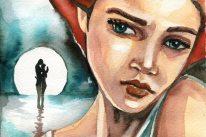
“The reason we struggle with insecurity is because we compare our behind-the-scenes with everyone else’s highlight reel.” ~Steve Furtick
We live in an artistically enriched country. The world is already full of all kinds of music, so much art, and so many books. With the Internet, you can experience art’s many forms at the click of a mouse.
In my heart, I am an artist. Ever since I was a young girl, I have loved creating artwork. Writing stories, drawing illustrations, playing the piano, painting, sculpting…
The unfortunate thing is that I am paralyzed—not in the medical sense. I have working limbs, imagination, training, experience, and the resources to “actualize my potential” as an artist. The thing I lack is confidence.
I am crippled by my own self-doubt.
When I was young, I didn’t seem to care about what other people thought. But the older I get, the more apprehensive I become. My fear of failure is greater than my fear of never creating anything ever again.
All artists, to some extent, have a very tough self-standard. The fear of falling short of your expectations can easily prevent you to create, particularly if you lack confidence.
Each time I see a beautiful painting, hear a moving song, come face to face with a realistic sculpture, or read an inspiring autobiography, I become immobilized. Instead of being stimulated by what I see, I get discouraged, and I am way less likely to create anything on my own. “The world doesn’t need anything else,” I think, “because it already has those.”
“What do I have to offer to the world? Why would anyone want to hear my voice? What original, unique art can I possibly create that doesn’t already exist? I might as well give up…”
I think this negativity comes from the bad habit of listening to my “inner critic” instead of focusing on “reality.”
If I let the pessimistic thoughts of my inner critic control my life, then I would never become the artist I want to be. My inner critic loves to put down my individuality and threaten me with failure. I’ve come to the conclusion that my inner critic doesn’t want me to succeed.
With that powerful information, each time I am tempted to belittle my individuality, I remember these four encouraging truths:
1. I am me, and there is no one else who is me. No one else can create what I can create.
2. Having courage doesn’t mean you’re not afraid. Having courage is taking action in spite of being afraid.
3. Your imperfections are part of who you are and part of what makes you beautiful. Be proud of being you, even with all your flaws and failures.
4. If you fail, so what! If you create art for the world, you will never be satisfied. Create art for yourself.
I often repeat these things to myself when I am doubtful, when my inner critic is running the show and ruining my life.
Becoming an individual artist can be very scary, especially if you have been paralyzed by fear for a long time. It’s comfortable to go along with the flow, to conform to the culture, and to continue on in the old ruts in road.
However, there is extraordinary life beyond the paved road. There is a giant wood, a great green meadow, an infinite horizon, and countless things to explore. If you always live your life according to the norm, then you will be missing out.
Life changing advice: You don’t have to believe what your inner critic tells you.
Do you have the strength to swim against the flow, to be an individual, to create your own art? Maybe not right this moment, you think, but there is something you can do to help yourself out. You can retrain your thoughts and learn to control your inner critic to allow reality have a rightful place in your life.
If I am experiencing an artist’s block, when I realize my inner critic has taken control, I take out a piece of paper and make two columns.
One reads “inner critic,” and the other reads “reality.” Underneath each header, I make lists (kind of like a pros and cons sheet), distinguishing one thought from the other.
One way to help determine which category to put your thoughts in is to listen to the tone of the thought’s voice (how you talk to yourself). If the tone is anxious, nervous, babbling, stereotypical, and offers you no way out, then it is your “inner critic.” If the tone is optimistic, unemotional, constructive, and practical then it is “realistic.”
Below is an example of a recent list I made while having trouble finishing a painting:
Inner Critic
- You can’t do it; you are a “nobody.”
- What if you make a mistake? No one will like you if you produce bad art.
- You will never be famous. You’re ugly and fat; ugly and fat people cannot produce good art.
- Artists are irresponsible. The world hates artists.
Reality
- I have artistic talent.
- Sometimes I let perfect get in the way of good.
- Most days I enjoy creating art.
- I am loved no matter what I do, even if I am not perfect.
- No else can be me; therefore, no one else can create what I can create.
This mental exercise will take practice, but over time, you will begin to see positive results in your life and your creativity.
At first, it will be difficult to distinguish your self-critic from reality, especially if you have obeyed your fears for a long time. If you try it, I guarantee that you will begin to enjoy a more nourishing, creatively enriched life in the process.
I have been utilizing this practice for a while now. After the first few months, I didn’t have to make physical lists anymore; I could separate the thoughts in my head. Even though, I am still a long way off from where I want to be, I am a lot closer to my goal than I was before.
What are some of your hurdles as an apprehensive artist? How do you overcome your obstacles?
Photo by TinyTall
About Mary Borchers
Mary Borchers is just like you—a girl trying to find her purpose in this world. She is passionate about living a nourishing life, physically, spiritually, mentally, and emotionally. Check out her personal blog http://haveanourishinglife.blogspot.com/, a journey to find sanity and sanctity in the midst of mental illness.













 Though I run this site, it is not mine. It's ours. It's not about me. It's about us. Your stories and your wisdom are just as meaningful as mine.
Though I run this site, it is not mine. It's ours. It's not about me. It's about us. Your stories and your wisdom are just as meaningful as mine. 